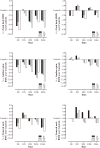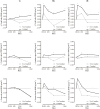Multilevel Approach of a 1-Year Program of Dietary and Exercise Interventions on Bone Mineral Content and Density in Metabolic Syndrome--the RESOLVE Randomized Controlled Trial
- PMID: 26376093
- PMCID: PMC4574281
- DOI: 10.1371/journal.pone.0136491
Multilevel Approach of a 1-Year Program of Dietary and Exercise Interventions on Bone Mineral Content and Density in Metabolic Syndrome--the RESOLVE Randomized Controlled Trial
Erratum in
-
Correction: Multilevel Approach of a 1-Year Program of Dietary and Exercise Interventions on Bone Mineral Content and Density in Metabolic Syndrome - the RESOLVE Randomized Controlled Trial.PLoS One. 2015 Oct 6;10(10):e0140307. doi: 10.1371/journal.pone.0140307. eCollection 2015. PLoS One. 2015. PMID: 26440101 Free PMC article. No abstract available.
Abstract
Background: Weight loss is a public health concern in obesity-related diseases such as metabolic syndrome (MetS). However, restrictive diets might induce bone loss. The nature of exercise and whether exercise with weight loss programs can protect against potential bone mass deficits remains unclear. Moreover, compliance is essential in intervention programs. Thus, we aimed to investigate the effects that modality and exercise compliance have on bone mineral content (BMC) and density (BMD).
Methods: We investigated 90 individuals with MetS who were recruited for the 1-year RESOLVE trial. Community-dwelling seniors with MetS were randomly assigned into three different modalities of exercise (intensive resistance, intensive endurance, moderate mixed) combined with a restrictive diet. They were compared to 44 healthy controls who did not undergo the intervention.
Results: This intensive lifestyle intervention (15-20 hours of training/week + restrictive diet) resulted in weight loss, body composition changes and health improvements. Baseline BMC and BMD for total body, lumbar spine and femoral neck did not differ between MetS groups and between MetS and controls. Despite changes over time, BMC or BMD did not differ between the three modalities of exercise and when compared with the controls. However, independent of exercise modality, compliant participants increased their BMC and BMD compared with their less compliant peers. Decreases in total body lean mass and negative energy balance significantly and independently contributed to decreases in lumbar spine BMC.
Conclusion: After the one year intervention, differences relating to exercise modalities were not evident. However, compliance with an intensive exercise program resulted in a significantly higher bone mass during energy restriction than non-compliance. Exercise is therefore beneficial to bone in the context of a weight loss program.
Trial registration: ClinicalTrials.gov NCT00917917.
Conflict of interest statement
Figures




Similar articles
-
Different modalities of exercise to reduce visceral fat mass and cardiovascular risk in metabolic syndrome: the RESOLVE randomized trial.Int J Cardiol. 2013 Oct 9;168(4):3634-42. doi: 10.1016/j.ijcard.2013.05.012. Epub 2013 May 25. Int J Cardiol. 2013. PMID: 23714599 Clinical Trial.
-
Does high-intensity resistance training maintain bone mass during moderate weight loss in older overweight adults with type 2 diabetes?Osteoporos Int. 2005 Dec;16(12):1703-12. doi: 10.1007/s00198-005-1906-4. Epub 2005 Jun 4. Osteoporos Int. 2005. PMID: 15937634 Clinical Trial.
-
Effects of lifestyle intervention on left ventricular regional myocardial function in metabolic syndrome patients from the RESOLVE randomized trial.Metabolism. 2016 Sep;65(9):1350-60. doi: 10.1016/j.metabol.2016.05.006. Epub 2016 May 18. Metabolism. 2016. PMID: 27506742 Clinical Trial.
-
Prospective ten-month exercise intervention in premenarcheal girls: positive effects on bone and lean mass.J Bone Miner Res. 1997 Sep;12(9):1453-62. doi: 10.1359/jbmr.1997.12.9.1453. J Bone Miner Res. 1997. PMID: 9286762
-
Beneficial impact of exercise on bone mass in individuals under calorie restriction: a systematic review and Meta-analysis of randomized clinical trials.Crit Rev Food Sci Nutr. 2021;61(4):553-565. doi: 10.1080/10408398.2020.1739620. Epub 2020 Mar 17. Crit Rev Food Sci Nutr. 2021. PMID: 32180431
Cited by
-
SOphrology Intervention to Improve WELL-Being in Hospital Staff (SO-WELL): Protocol for a Randomized Controlled Trial Study.Int J Environ Res Public Health. 2023 Jan 9;20(2):1185. doi: 10.3390/ijerph20021185. Int J Environ Res Public Health. 2023. PMID: 36673939 Free PMC article.
-
Effect of exercise training on heart rate variability in type 2 diabetes mellitus patients: A systematic review and meta-analysis.PLoS One. 2021 May 17;16(5):e0251863. doi: 10.1371/journal.pone.0251863. eCollection 2021. PLoS One. 2021. PMID: 33999947 Free PMC article.
-
Stress management in obesity during a thermal spa residential programme (ObesiStress): protocol for a randomised controlled trial study.BMJ Open. 2019 Dec 23;9(12):e027058. doi: 10.1136/bmjopen-2018-027058. BMJ Open. 2019. PMID: 31874865 Free PMC article.
-
Long-term cost reduction of routine medications following a residential programme combining physical activity and nutrition in the treatment of type 2 diabetes: a prospective cohort study.BMJ Open. 2017 Apr 16;7(4):e013763. doi: 10.1136/bmjopen-2016-013763. BMJ Open. 2017. PMID: 28416496 Free PMC article.
-
Weighted Vest Use during Dietary Weight Loss on Bone Health in Older Adults with Obesity.J Osteoporos Phys Act. 2017;5(4):210. doi: 10.4172/2329-9509.1000210. Epub 2017 Nov 28. J Osteoporos Phys Act. 2017. PMID: 29388604 Free PMC article.
References
-
- Hinton PS, LeCheminant JD, Smith BK, Rector RS, Donnelly JE (2009) Weight loss-induced alterations in serum markers of bone turnover persist during weight maintenance in obese men and women. Journal of the American College of Nutrition 28: 565–573. - PubMed
-
- Sukumar D, Ambia-Sobhan H, Zurfluh R, Schlussel Y, Stahl TJ, Gordon CL, et al. (2011) Areal and volumetric bone mineral density and geometry at two levels of protein intake during caloric restriction: A randomized, controlled trial. Journal of Bone and Mineral Research 26: 1339–1348. 10.1002/jbmr.318 - DOI - PMC - PubMed
Publication types
MeSH terms
Associated data
LinkOut - more resources
Full Text Sources
Other Literature Sources
Medical

